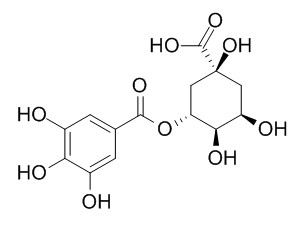3-Galloylquinic acid
Theogallin(3-Galloylquinic acid ), its derivatives, its metabolite quinic acid, the derivatives thereof, its metabolites or the pharmaceutically acceptable salts of said substances can be used for producing a drug for use in the prophylaxis or treatment of neurological and psychiatric diseases of the central nervous system, especially of dementia such as Alzheimer's disease or Parkinson's disease, of depressions and concentration disorders such as attention deficit hyperactivity disorder.L-theanine- and theogallin-enriched decaffeinated green tea extract are able to change the physiological pattern of electrical hippocampus activity in a concentration dependent manner (EC50=3mg/L), they can improve cognition at concomitant mental relaxation in man. Theogallin also has scavenging radical activity.
Inquire / Order:
manager@chemfaces.com
Technical Inquiries:
service@chemfaces.com
Tel:
+86-27-84237783
Fax:
+86-27-84254680
Address:
1 Building, No. 83, CheCheng Rd., Wuhan Economic and Technological Development Zone, Wuhan, Hubei 430056, PRC
Providing storage is as stated on the product vial and the vial is kept tightly sealed, the product can be stored for up to
24 months(2-8C).
Wherever possible, you should prepare and use solutions on the same day. However, if you need to make up stock solutions in advance, we recommend that you store the solution as aliquots in tightly sealed vials at -20C. Generally, these will be useable for up to two weeks. Before use, and prior to opening the vial we recommend that you allow your product to equilibrate to room temperature for at least 1 hour.
Need more advice on solubility, usage and handling? Please email to: service@chemfaces.com
The packaging of the product may have turned upside down during transportation, resulting in the natural compounds adhering to the neck or cap of the vial. take the vial out of its packaging and gently shake to let the compounds fall to the bottom of the vial. for liquid products, centrifuge at 200-500 RPM to gather the liquid at the bottom of the vial. try to avoid loss or contamination during handling.
Int. J. Mol. Sci.2022, 23(19), 11900.
Int J Mol Sci.2021, 22(21):11447.
Applied Biological Chemistry2021, 64(4)
Chemistry of Natural Compounds2018, 204-206
Chem Biol Interact.2019, 315:108910
Biomolecules.2020, 10(2):E184
Int J Mol Sci.2022, 23(21):12816.
Foods.2023, 12(12):2412.
Metab Eng.2022, 75:143-152.
Asian Pac J Cancer Prev.2019, 20(1):65-72
Related and Featured Products
J. Pharm. Pharmacol., 2007, 59(8):1131-6.
Theogallin and L-theanine as active ingredients in decaffeinated green tea extract: I. electrophysiological characterization in the rat hippocampus in-vitro.[Pubmed:
17725856 ]
The in-vitro hippocampus slice preparation was used to mimic a physiological situation where nervous tissue is exposed directly to the water soluble extract of green tea and some of its constituents. This investigation provides evidence that L-theanine- and theogallin(3-Galloylquinic acid )--enriched decaffeinated green tea extract is able to change the physiological pattern of electrical hippocampus activity in a concentration dependent manner (EC50 3 mg L(-1)).
METHODS AND RESULTS:
Of the seven fractions or single components tested (fraction containing all amino acids without L-theanine, fractions containing all amino acids plus L-theanine, glutamic acid, theogallin, its metabolites quinic acid and gallic acid, and L-theanine alone), glutamic acid produced the strongest changes in terms of increased population spike amplitude after single stimuli and increased long-term potentiation, commonly taken as representative for enhancement of spatial and time dependent memory. The presence of theogallin alone shifted the activity in the same direction. Similar results as with theogallin were obtained in the presence of quinic acid. No effect was seen with gallic acid. Opposite changes (decrease of population spike amplitude and attenuated long-term potentiation) were observed in the presence of L-theanine alone. No effects were detected during the addition of the amino acid mixture unless L-theanine was added, leading to a decrease of the responses as observed for the action of L-theanine alone.
CONCLUSIONS:
The results provide evidence for the involvement of several active principles in the action of enriched green tea extract on electrical brain activity. The overall enhancement of hippocampal pyramidal cell responses as observed for the crude extract seems to be due to the combined action of glutamic acid and theogallin (or its presumable metabolite quinic acid), whereas L-theanine seems to have an opposite effect. However, this action was not strong enough to antagonize the effects of glutamic acid and theogallin.The results are in line with the observation that the tested green tea extract improves cognition at concomitant mental relaxation in man.
Phytochemistry.1971 Jul;10(7):1671–1673.
The identification of theogallin as 3-galloylquinic acid.[Reference:
WebLink]
METHODS AND RESULTS:
The structure of theogallin, found in unprocessed tea leaf, was confirmed as 3-Galloylquinic acid by NMR spectroscopy.



